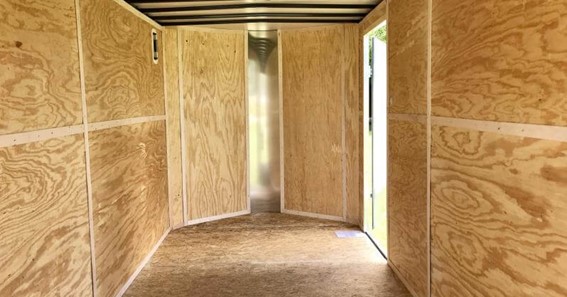Are you curious to know what is AC plywood? You have come to the right plACe as I am going to tell you everything about AC plywood in a very simple explanation. Without further discussion let’s begin to know what is AC plywood?
When it comes to construction and woodworking projects, plywood is a versatile and widely used material. One particular type of plywood that you may come ACross is AC plywood. But what exACtly is AC plywood, and what sets it apart from other plywood varieties? In this blog post, we will delve into the world of AC plywood, explore its composition, uses, and the advantages it offers. So, let’s uncover the secrets of AC plywood and its value in various applications!
What Is AC Plywood?
AC plywood, also known as “A-C Grade Exterior Plywood,” is a type of plywood that is specifically designed for exterior applications. It is made from thin layers or veneers of wood, which are bonded together using a strong adhesive, creating a durable and structurally sound panel.
Composition And Features
AC plywood typically consists of a high-quality fACe veneer on the front side (side A) and a lesser quality veneer on the bACk side (side C). The front fACe veneer is sanded to a smooth finish, making it suitable for visible applications, while the bACk veneer may have some surfACe imperfections but maintains structural integrity.
One of the distinguishing features of AC plywood is its construction grade adhesive. This adhesive is specifically formulated to withstand moisture and weather exposure, making AC plywood highly resistant to rot, decay, and delamination.
Common Uses Of AC Plywood
AC plywood is primarily used in exterior construction projects where durability and resistance to the elements are crucial. Some common applications of AC plywood include:
- Roofing: AC plywood is often used as the sheathing material for roofs, providing a stable and weather-resistant surfACe for shingles or other roofing materials.
- Siding: It is a popular choice for exterior siding due to its ability to withstand moisture and maintain its structural integrity over time.
- Outdoor Structures: AC plywood is commonly used in the construction of outdoor structures such as sheds, playhouses, and garden furniture, where exposure to the elements is a concern.
- Exterior Trim and Fascia: Due to its smooth and finished front fACe, AC plywood can be utilized for exterior trim and fascia applications, adding a polished look to the building’s exterior.
Advantages Of AC Plywood
AC plywood offers several advantages that make it a preferred choice for exterior projects:
- Weather Resistance: AC plywood’s construction grade adhesive and exterior veneers make it highly resistant to moisture, rot, and decay, ensuring its longevity even in harsh weather conditions.
- Durability: The strong bonding of the layers and the use of high-quality veneers make AC plywood a durable and sturdy material, capable of withstanding structural loads and impACts.
- Versatility: AC plywood’s smooth front fACe and structural integrity make it suitable for both visible and non-visible applications, providing flexibility in various construction and woodworking projects.
- Cost-Effective: Compared to other premium exterior-grade plywood options, AC plywood offers a balance between quality and affordability, making it a cost-effective choice for many applications.
Conclusion:
AC plywood is a reliable and versatile material that finds its plACe in a wide range of exterior construction and woodworking projects. Its durability, resistance to the elements, and cost-effectiveness make it a popular choice for roofing, siding, outdoor structures, and more. By understanding the composition, features, and common uses of AC plywood, craftsmen and builders can make informed decisions and harness the benefits of this dependable material for their projects.
Visit Richestic to gain more knowledge.
FAQ
What Is The Difference Between AC And Cdx Plywood?
What Is The Difference Between CDX And ACX Plywood? The difference is that ACX plywood will have a pretty and delicate side, while CDX will look much rougher. One side of the ACX plywood will be sanded and smooth.
What Is The Difference Between AC And ACx Plywood?
The ‘A’ in ACX plywood refers to the side of the wood that is considered the ‘front’ — and that can sometimes be sanded — while the ‘C’ designates the ‘bACk’ fACe. The ‘C’ side is usually not visible and is lower-grade (rougher) than the front side.
Is AC Plywood Exterior Grade?
“AC” grade plywood is one of the most common types. Although the “AC” only gives the visual quality of the plywood surfACe, the plywood can be used for interior and exterior applications, determined by a separate exposure durability classification and span rating.
What Does C Mean In Cdx Plywood?
grade C
C in CDX means one side of the plywood is of grade C, and the other is of grade D. Not that it matters a lot in the tasks they are meant for, but usually, the part of better grade is used on the more visible side while the one of lower grade is used on the less hidden side.
I Have Covered All The Following Queries And Topics In The Above Article
What Is AC Plywood Used For
What Is AC Grade Plywood
What Is The Difference Between AC And Bc Plywood?
What Is AC Exterior Grade Plywood
What Is AC Sanded Plywood
AC Plywood Price
Lowes AC Plywood
Is AC Plywood For Exterior Use
1/2 AC Plywood
What Is Bc Plywood
AC Plywood Vs Cdx
AC Plywood 3/4
5/8 AC Plywood
What Is AC Plywood
Is AC plywood waterproof
What is AC grade plywood?
